For those who have worked with a lot of collected junipers, this post can be summed up with two photos.
Sierra juniper before repotting- 31″ tall
Sierra juniper after repotting
I acquired this tree in the pot pictured at top so I assumed there were some important roots that emerged quite a ways from the trunk. The hope is always that there are some roots closer in which would facilitate planting the tree in a smaller container.
When I took the tree out of its container, I was happy to see lots of fine roots everywhere. The question remained, however, where the roots came from.
I began my investigation on the left side of the rootball as it was the furthest point from the base of the trunk.
Fine roots at the end of a long root on the left side
I found that I could shorten the trunk a few inches without losing many roots.
The end section of the long root
Further investigation revealed a significant root with a lot of fine roots attached. I was curious of there were other significant roots so I followed the main root back to the trunk. Along the way, I no additional roots.
The long root on the left side
The right side also proved to be a bust. Although the deadwood is nice on that side, there is no active lifeline.
Right side of the rootball – the fine roots all emerge from the big root at the far end of the tree
As soon as I realized the tree was far from ready for a bonsai pot, I planted it in a narrow wooden box where it can grow for a year or two before I line up some root grafts. In the meantime, I can start thinking about how to design a compact tree around the deadwood along the trunk.
Trunk detail
Subscribe to Bonsai Tonight
New Posts Delivered Every Tuesday and Friday
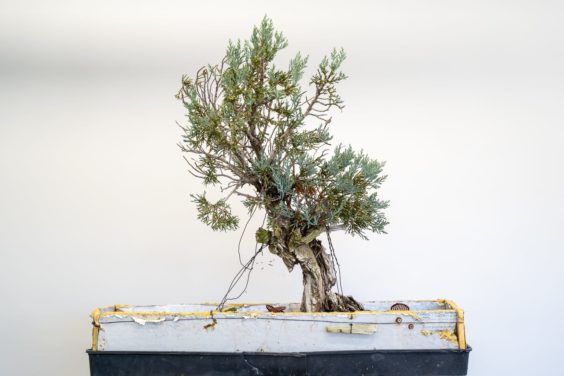
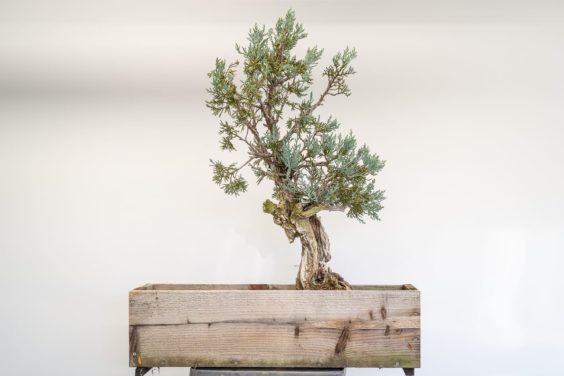
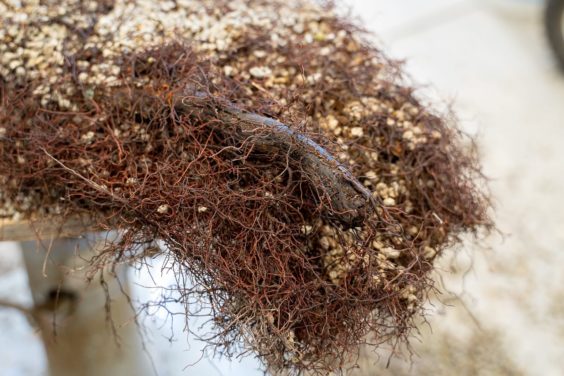
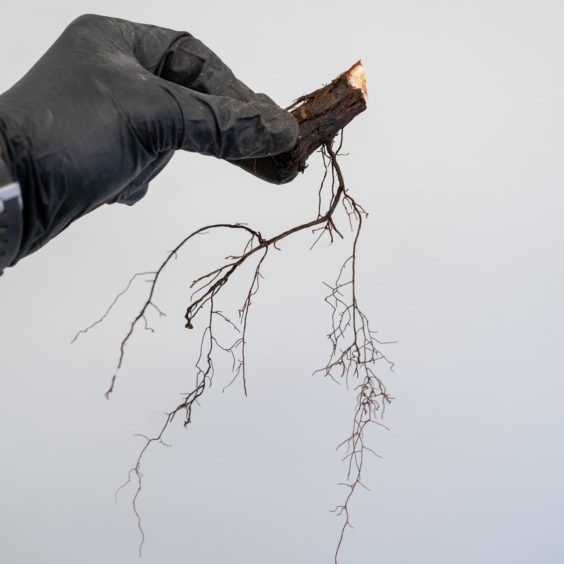
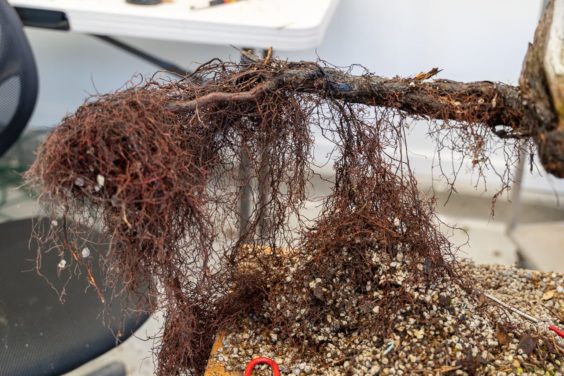
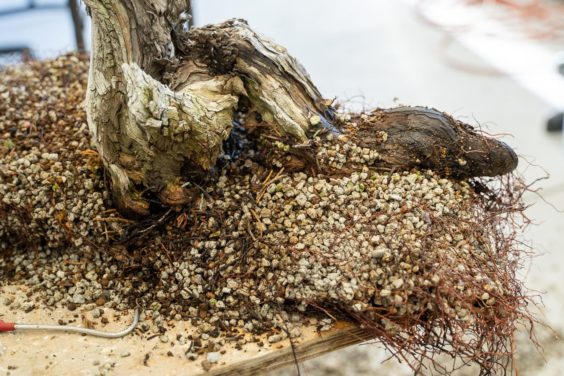
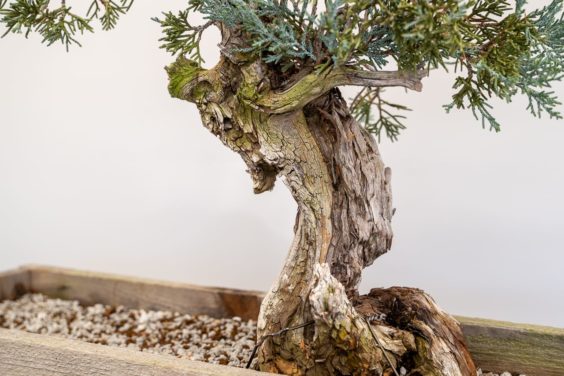
Zack A. Clayton says
This is a nice description of why you want to know what is undergorund before starting to chop away at the rootball. I have seen many beginner- medium skilled folks just start chopping in workshops. Sometimes they kill their tree before they even start looking at the top. Then they wonder why it “died” a month later.
Would rooting compound close to the trunk on that long root do any good?
Jonas Dupuich says
Good question Zack, I haven’t experimented with root hormones like this yet so I don’t know if it can make an appreciable difference.
Leonard Bell says
I haven’t seen it done before, but could you have wired the long root to the left and slowly over time bent it towards the center?
Jonas Dupuich says
Hi Leonard – yes, the root can be bent into a smaller shape in order to fit the tree in a pot without grafting. This can be done by gradual bending over time or by using raffia and separating the live veins from the dead parts of the roots and bending it into place all at once. I didn’t want to take this approach at this point as the main line from which the root was growing was not totally intact.
scott chadd says
i have found that it is better to cut roots close to the trunk when lifting Sierra Junipers from nature. if the tree is strong it will strike roots from the place the root is cut whether short or long
Jonas Dupuich says
Thanks Scott – I like doing the same, though I’d hesitate if it meant cutting all living roots from the tree.
Ben watts says
Could you not cut the big root on the left, back to some of those finer roots hanging off of it? Or are they too sparce to sustain the tree?
Joseph W Perry says
Very interesting, thank you! I’ve been working with juniper since I started bonsai in 2012, and at this point I am usually very successful. I’ve had no problem with yamadori RMJ, yamadori Utah Juniper, that rascal the Common Juniper (collected in the Dakotas), Ashe Juniper from the Ozarks… I’ve even played around quite a bit with my local species, the ubiquitous and ever unwilling to comply Eastern Red Cedar.
My one big hiccup with juniper recently was with a Sierra Juniper yamadori I received from Cali in Spring of 2018. It was a small semi-cascade and I was told by the seller that it was over two years post collection. I’m not sure if that dating was correct, or if there was a species specific phenomenon occurring that I am not aware of, but something went very wrong with that poor juniper.
After arrival, the juniper had thin and lank foliage, but nothing that concerned me outright. Lots of North American juniper have loose foliage and it can be sparse. Additionally, I did not encounter any signs that damage was inflicted during. The box was big, filled with peanuts, and totally intact.
Anyway, I gave this juniper a few days of (mostly shade) to recover from any travel shock, and then I nipped the anchoring wires to see what I was working with beneath the soil. What I found… wow. I understand that the strength of juniper is in the foliage, but still, I’d never seen a living juniper with so few roots. I was terrified that it was recently collected months, not years, ago! After calming down, I convinced myself that Sierra Juniper must grow in tiny dry crevices and they have adapted to only having a few roots, so I figured my little yamadori must have been OK. I was wrong.
Even if Sierra Juniper physiology is different regarding how many roots they require, I was still intimidated by what I saw. I didn’t cut a single root, but I still put the tree back into a bonsai pot and not the trainer. This was a proper semi-cascade pot not much smaller in volume than the plastic grow pot. The juniper arrived to me in Boon’s mix, and the only deviation from that original substrate that occurred was me adding some fresh akadama to the existing blend.
Within days of being slip potted into the semi-cascade pot, this juni began to crash!
In my experience, junipers are a resilient genus of tree/shrub, and they will let you push them pretty hard. If you decide not to water a juniper for a month, any species from this tough genus will slowly die. IMO, it is hard to convince a juniper to recover health once it shows a lot of stress in the foliage. Recent-to-bonsai folks may think a juniper like this still has a chance because of genus’ slow decline and the proclivity for the needle/scales to stay green for a while even postmortem. It’s deceptive.
Also, these doomed junipers, in my experience, eventually show death/foliage death from the outside in. Tips first and eventually moving into the core of the scale/needles and progressing down to the heart of the tree with that first branch being the last part to go.
None of this happened with my Sierra Juniper! The timeline for this tree is: arrival -> slip pot three days later -> immediate and fast decline from the inside out. Total death within 10 days of slip potting!
I’ve never seen a juniper tank so fast. And from the inside out? My theory is that when I slip potted this little yamadori, whatever tenuous grasp it had on life was disrupted.
Or maybe when I anchored the tree, a wire might have clipped the one good root. I have no idea.
The seller seemed and still seems like a nice fellow. I hope he doesn’t dig his own trees, but instead buys them from other hunters. I’d like to think he wasn’t lying to me unless he had been lied to first, himself. Or, potentially, as I mentioned, this could be a thing with Sierra Juniper! Maybe the seller did collect the yamadori a few years back and the root regrowth issue is a common one. I have no idea! Do you?
I hope so, lol. The seller offered me credit with him for another purchase but I never saw another piece of material that I was interested in. Now that it is almost a full year later, I’m not even going to remind the guy. Just bad luck (hopefully!).
If, however, there is a lesson to be learned from this Sierra juniper that will help me avoid repeating the sudden death, I’d love to learn it. Along with Western juniper, they are an iconic American confer and I wouldn’t mind another shot at one.
I keep Engelmann spruce healthy in the Northeast, so I can handle fussy species, but maybe I’m missing something else with Sierra Juniper care? My arid species like Ponderosa Pine don’t seem to mind the amount of moisture I subject them to, and even if they objected to too much humidity in the summer, it’s not like that was happening in the spring. Also, the decline was too fast for any oversaturation of h2o to have been the cause (methinks).
Ok, I know that was really long, so thanks for reading and any suggestions I might receive. Ideally, all my yamadori would come from names that I recognize such as Andy Smith, Sam Miller, Todd Schlafer, etc. All those guys only sell the best and healthiest material. Sadly, those guys stick to one territory and so I end up taking risks with unknown entities for the other species that I want to work with.
Best,
Joe
Jonas Dupuich says
Wow, thanks for sharing your juniper story Joe – am sorry to hear the tree took a dive so quickly! In my experience, the details you note about how junipers grow rings true. The only things that come to mind are that a) there was some disruption of the (weak) root system when you repotted or b) the tree was about to tank and your timing was unfortunate. The latter option is very possible, but it’s hard to say if the timing was coincidental. Due to your success with other collected species, it seems unlikely that your care could have been so far off to have killed a tree within two weeks. That leaves the disruption of the roots during repotting as a good candidate. Here it sounds like the issue was that the tree didn’t have the expected number of roots for a tree that was two years out of the ground. I’ve found that Sierras can stay green for up to two years with zero healthy roots. In these cases, even a simple repotting can be fairly stressful for the trees.
The only takeaway I can think of is to buy trees that have put on significant new growth since they were collected as that’s the one sure way to tell that the tree has healthy roots.
Thanks again for sharing Joe!
Joseph W Perry says
Wow, I am so glad I asked! At this point, when a tree dies unexpectedly in my care, especially yamadori, I want to know what went wrong.. This definitely clarifies some things for me. Before I only had my theories and not enough anecdotal evidence to support them with such a small sample size of Sierra junis. Now I can add a bit more finality to that mystery, even if we will never really know for 100% certain. Anyway, I appreciate the help! Thanks!
Regards,
Joe